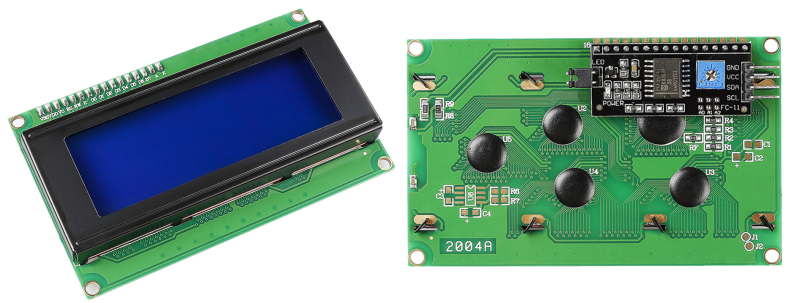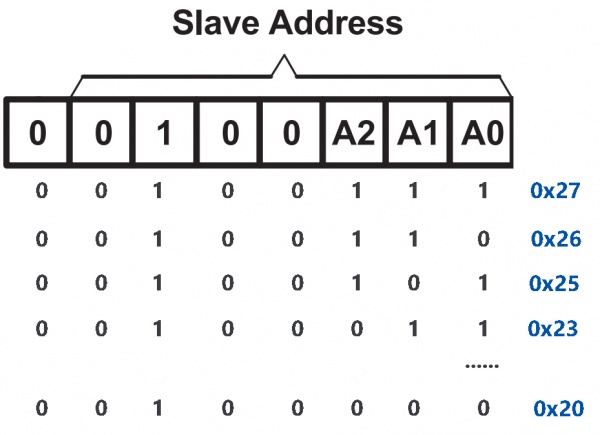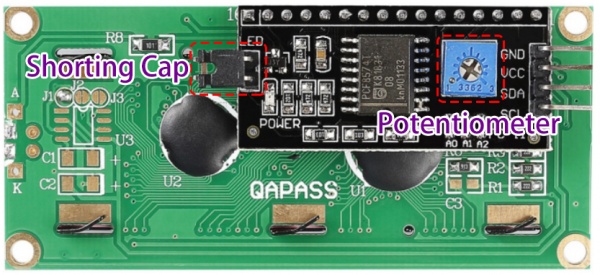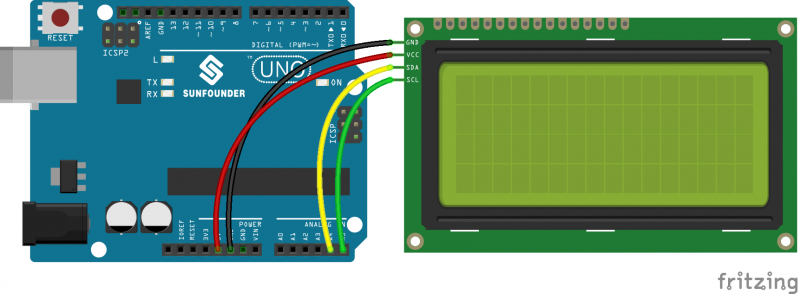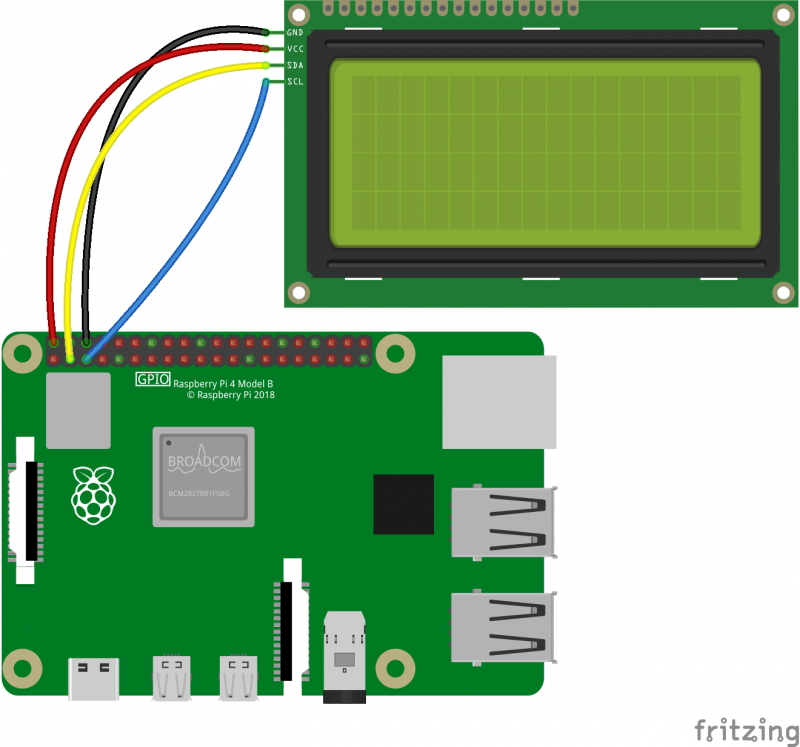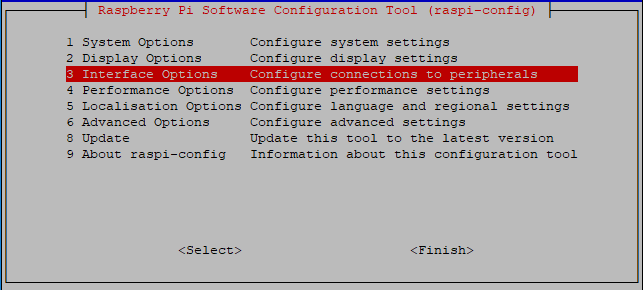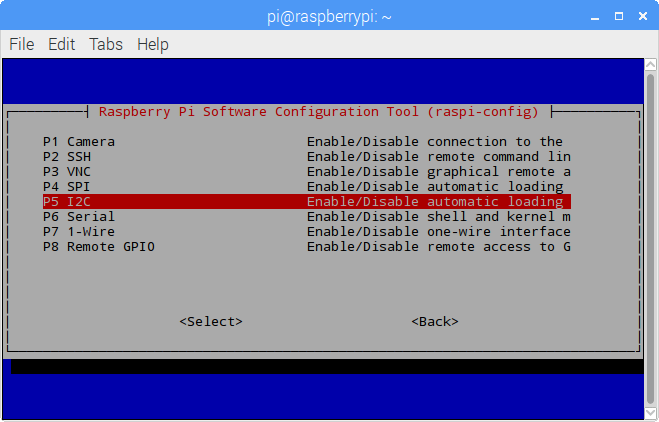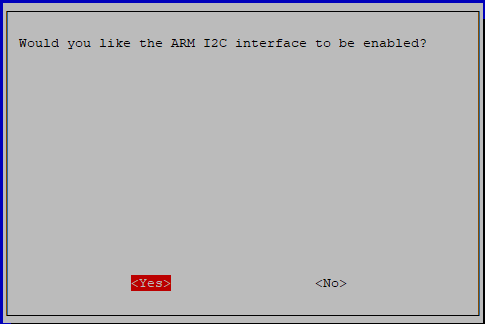Difference between revisions of "I2C LCD2004"
(→Download and run the code) |
|||
| (32 intermediate revisions by the same user not shown) | |||
| Line 1: | Line 1: | ||
| − | + | =='''Introduction'''== | |
| − | ='''Introduction'''= | + | |
| − | + | ||
As we all know, though LCD and some other displays greatly enrich the man-machine interaction, they share a common weakness. When they are connected to a controller, multiple IOs will be occupied of the controller which has no so many outer ports. Also it restricts other functions of the controller. Therefore, LCD2004 with an I2C bus is developed to solve the problem.<br> | As we all know, though LCD and some other displays greatly enrich the man-machine interaction, they share a common weakness. When they are connected to a controller, multiple IOs will be occupied of the controller which has no so many outer ports. Also it restricts other functions of the controller. Therefore, LCD2004 with an I2C bus is developed to solve the problem.<br> | ||
I2C bus is a type of serial bus invented by PHLIPS. It is a high performance serial bus which has bus ruling and high or low speed device synchronization function required by multiple host system. I2C bus has only two bidirectional signal lines, Serial Data Line (SDA) and Serial Clock Line (SCL). The blue potentiometer on the I2C LCD2004 is used to adjust backlight to make it easier to display on the I2C LCD2004. | I2C bus is a type of serial bus invented by PHLIPS. It is a high performance serial bus which has bus ruling and high or low speed device synchronization function required by multiple host system. I2C bus has only two bidirectional signal lines, Serial Data Line (SDA) and Serial Clock Line (SCL). The blue potentiometer on the I2C LCD2004 is used to adjust backlight to make it easier to display on the I2C LCD2004. | ||
| − | =''' | + | |
| − | =='''Components'''== | + | [[File:I2c lcd2004.png|800px]]<br> |
| + | |||
| + | - '''GND''': Ground<br> | ||
| + | - '''VCC''': Voltage supply, 5V.<br> | ||
| + | - '''SDA''': Serial data line. Connect to VCC through a pullup resistor.<br> | ||
| + | - '''SCL''': Serial clock line. Connect to VCC through a pullup resistor.<br> | ||
| + | |||
| + | =='''I2C Address'''== | ||
| + | |||
| + | The default address is basically 0x27, in a few cases it may be 0x3F. | ||
| + | |||
| + | Taking the default address of 0x27 as an example, the device address can be modified by shorting the A0/A1/A2 pads; in the default state, A0/A1/A2 is 1, and if the pad is shorted, A0/A1/A2 is 0. | ||
| + | |||
| + | [[Image:I2c address.jpg|600px]]<br> | ||
| + | |||
| + | |||
| + | =='''Backlight/Contrast'''== | ||
| + | |||
| + | Backlight can be enabled by jumper cap, unplug the jumper cap to disable the backlight. The blue potentiometer on the back is used to adjust the contrast (the ratio of brightness between the brightest white and the darkest black). | ||
| + | |||
| + | [[Image:Back lcd1602.jpg|600px]]<br> | ||
| + | |||
| + | |||
| + | - '''Shorting Cap''': Backlight can be enabled by this cap,unplug this cap to disable the backlight.<br> | ||
| + | - '''Potentiometer''': It is used to adjust the contrast (the clarity of the displayed text), which is increased in the clockwise direction and decreased in the counterclockwise direction.<br> | ||
| + | |||
| + | =='''For Arduino User'''== | ||
| + | |||
| + | ==='''<font color="orange">Components</font>'''=== | ||
- 1 *SunFounder Mars board <br> | - 1 *SunFounder Mars board <br> | ||
- 1 * I2C LCD2004 module<br> | - 1 * I2C LCD2004 module<br> | ||
- 1 * USB cable<br> | - 1 * USB cable<br> | ||
- Several jump wires<br> | - Several jump wires<br> | ||
| − | ==''' | + | ==='''<font color="orange">Connect the circuit</font>'''=== |
| − | + | ||
| − | + | ||
| − | + | ||
| − | + | ||
| − | + | ||
| − | + | ||
| − | + | ||
| − | + | ||
See the following table for connection between the I2C LCD2004 and the SunFounder Uno board:<br> | See the following table for connection between the I2C LCD2004 and the SunFounder Uno board:<br> | ||
<center> | <center> | ||
| Line 24: | Line 42: | ||
|- | |- | ||
! scope="col" | I2C LCD2004 | ! scope="col" | I2C LCD2004 | ||
| − | ! scope="col" | | + | ! scope="col" | Arduino Board |
|- | |- | ||
| Line 41: | Line 59: | ||
</center> | </center> | ||
| − | === | + | [[Image:Arduino i2c lcd2004.png|800px]]<br> |
| + | |||
| + | ==='''<font color="orange">Add library</font>'''=== | ||
Before you upload the code to the control board,you neeed to add the LiquidCrystal_I2C library.<br> | Before you upload the code to the control board,you neeed to add the LiquidCrystal_I2C library.<br> | ||
| − | 1) Download the '''LiquidCrystal_I2C library | + | 1) Download the [http://wiki.sunfounder.cc/images/7/7e/LiquidCrystal_I2C.zip '''LiquidCrystal_I2C library''']<br> |
<br> | <br> | ||
2) Open the Arduino IDE,Select Sketch -> Include Library -> Add ZIP Library<br> | 2) Open the Arduino IDE,Select Sketch -> Include Library -> Add ZIP Library<br> | ||
| Line 51: | Line 71: | ||
3) Find the file LiquidCrystal_I2C which you just download. Click it open and then you'll be prompted by "Library added to your libraries. Check 'Import libraries'”. You also can see the libraries just imported have appeared on the list by Sketch->Include Library->LiquidCrystal_I2C.<br> | 3) Find the file LiquidCrystal_I2C which you just download. Click it open and then you'll be prompted by "Library added to your libraries. Check 'Import libraries'”. You also can see the libraries just imported have appeared on the list by Sketch->Include Library->LiquidCrystal_I2C.<br> | ||
[[File:Fdfds.png]] <br> | [[File:Fdfds.png]] <br> | ||
| − | <br> | + | <br> |
| − | === | + | |
| − | Copy the | + | ==='''<font color="orange">Copy the code</font>'''=== |
| + | Copy the following code to the Arduino IDE | ||
<pre> | <pre> | ||
/***************************************** | /***************************************** | ||
| Line 64: | Line 85: | ||
/********************************/ | /********************************/ | ||
| − | // | + | // Include necessary libraries |
#include <Wire.h> | #include <Wire.h> | ||
#include <LiquidCrystal_I2C.h> | #include <LiquidCrystal_I2C.h> | ||
| − | + | ||
| + | // Initialize the LCD object, set the LCD I2C address to 0x27 for a 20x4 display | ||
| + | LiquidCrystal_I2C lcd(0x27, 20, 4); | ||
| + | |||
/*********************************************************/ | /*********************************************************/ | ||
void setup() | void setup() | ||
{ | { | ||
| − | lcd.init(); | + | lcd.init(); // Initialize the LCD |
| − | lcd.backlight(); | + | lcd.backlight(); // Turn on the backlight |
| − | + | ||
| − | lcd.setCursor ( 0, 0 ); | + | // Set cursor to the top left corner and print the string on the first row |
| − | lcd.print(" Hello,world! "); // | + | lcd.setCursor(0, 0); |
| − | lcd.setCursor ( 0, 1 ); | + | lcd.print(" Hello, world! "); |
| − | lcd.print(" IIC/I2C LCD2004 "); // | + | |
| − | lcd.setCursor ( 0, 2 ); | + | // Move to the second row and print the string |
| − | lcd.print(" 20 cols, 4 rows "); // | + | lcd.setCursor(0, 1); |
| − | lcd.setCursor ( 0, 3 ); | + | lcd.print(" IIC/I2C LCD2004 "); |
| + | |||
| + | // Move to the third row and print the string | ||
| + | lcd.setCursor(0, 2); | ||
| + | lcd.print(" 20 cols, 4 rows "); | ||
| + | |||
| + | // Move to the fourth row and print the string | ||
| + | lcd.setCursor(0, 3); | ||
lcd.print(" www.sunfounder.com "); | lcd.print(" www.sunfounder.com "); | ||
} | } | ||
| Line 87: | Line 117: | ||
void loop() | void loop() | ||
{ | { | ||
| − | + | // Empty loop | |
} | } | ||
/************************************************************/ | /************************************************************/ | ||
| + | |||
</pre> | </pre> | ||
| − | === | + | |
| + | ==='''<font color="orange">Upload the code</font>'''=== | ||
Before upload the code ,you need to select correct Board and Port,please follow the steps:<br> | Before upload the code ,you need to select correct Board and Port,please follow the steps:<br> | ||
<br> | <br> | ||
| Line 107: | Line 139: | ||
<br> | <br> | ||
If "Done uploading" appears at the bottom of the window, it means the sketch has been successfully uploaded.<br> | If "Done uploading" appears at the bottom of the window, it means the sketch has been successfully uploaded.<br> | ||
| − | |||
| − | |||
| − | |||
| − | ==''' | + | ==='''<font color="orange">Read I2C Address</font>'''=== |
| − | If everything is correct, | + | If everything is correct, but the display just shows 16 black rectangles on Line 1.it may be the address of i2c is not 0x27,therfore you need to run the following code to read the address,then modify the 0x27 to which you read. |
<pre> | <pre> | ||
LiquidCrystal_I2C lcd(0x27,16,2); | LiquidCrystal_I2C lcd(0x27,16,2); | ||
| Line 118: | Line 147: | ||
<pre> | <pre> | ||
/***************************************************** | /***************************************************** | ||
| − | * | + | * Name: I2C_Address |
| − | * | + | * Function: Read the address of the I2C LCD1602 |
* Connection: | * Connection: | ||
| − | * I2C UNO | + | * I2C Arduino UNO |
* GND GND | * GND GND | ||
| − | * VCC | + | * VCC 5V |
| − | * SDA | + | * SDA A4 (pin 20 in Mega2560) |
| − | * SCL | + | * SCL A5 (pin 21 in Mega2560) |
********************************************************/ | ********************************************************/ | ||
| − | #include <Wire.h> | + | #include <Wire.h> // Include Wire library for I2C communication |
| − | void setup() | + | void setup() { |
| − | { | + | Wire.begin(); // Initialize I2C communication |
| − | Wire.begin(); | + | Serial.begin(9600); // Start serial communication at 9600 baud rate |
| − | Serial.begin(9600); | + | Serial.println("\nI2C Scanner"); // Print a message to the serial monitor |
| − | Serial.println("\nI2C Scanner"); | + | |
} | } | ||
| − | void loop() | + | |
| − | { | + | void loop() { |
| − | byte error, address; | + | byte error, address; // Declare variables for storing error status and I2C address |
| − | int nDevices; | + | int nDevices; // Variable to keep track of number of devices found |
| − | Serial.println("Scanning..."); | + | |
| − | nDevices = 0; | + | Serial.println("Scanning..."); // Print scanning message |
| − | for(address = 1; address < 127; address++ ) | + | nDevices = 0; // Initialize the device count to 0 |
| − | + | ||
| − | + | // Loop through all possible I2C addresses (1 to 126) | |
| − | + | for (address = 1; address < 127; address++) { | |
| − | + | Wire.beginTransmission(address); // Start a transmission to the I2C address | |
| − | Wire. | + | error = Wire.endTransmission(); // End the transmission and get the status |
| − | error | + | |
| − | if (error == 0) | + | // Check if device responded without error (acknowledged) |
| − | + | if (error == 0) { | |
| − | Serial.print("I2C device found at address 0x"); | + | Serial.print("I2C device found at address 0x"); // Notify device found |
| − | if (address<16) | + | if (address < 16) Serial.print("0"); // Print leading zero for addresses less than 16 |
| − | + | Serial.print(address, HEX); // Print the address in hexadecimal | |
| − | Serial.print(address,HEX); | + | Serial.println(" !"); |
| − | Serial.println(" !"); | + | nDevices++; // Increment the device count |
| − | nDevices++; | + | } else if (error == 4) { // If there was an unknown error |
| − | } | + | Serial.print("Unknown error at address 0x"); // Notify about the error |
| − | + | if (address < 16) Serial.print("0"); // Print leading zero for addresses less than 16 | |
| − | + | Serial.println(address, HEX); // Print the address in hexadecimal | |
| − | Serial.print(" | + | |
| − | if (address<16) | + | |
| − | + | ||
| − | Serial.println(address,HEX); | + | |
} | } | ||
} | } | ||
| + | |||
| + | // After scanning, print the results | ||
if (nDevices == 0) | if (nDevices == 0) | ||
| − | Serial.println("No I2C devices found\n"); | + | Serial.println("No I2C devices found\n"); // No devices found |
else | else | ||
| − | Serial.println("done\n"); | + | Serial.println("done\n"); // Scanning done |
| − | delay(5000); // | + | |
| + | delay(5000); // Wait 5 seconds before the next scan | ||
} | } | ||
</pre> | </pre> | ||
| + | |||
| + | =='''For Raspberry Pi User'''== | ||
| + | |||
| + | ==='''<font color="orange">Build the circuit</font>'''=== | ||
| + | |||
| + | [[Image:Raspberry i2c lcd2004 bb.png|800px]]<br> | ||
| + | |||
| + | ==='''<font color="orange">Setup I2C</font>'''=== | ||
| + | |||
| + | |||
| + | Enable the I2C port of your Raspberry Pi (If you have | ||
| + | enabled it, skip this; if you do not know whether you have done that or | ||
| + | not, please continue).<br> | ||
| + | |||
| + | '''Step 1''': Run the following command.<br> | ||
| + | <pre> | ||
| + | sudo raspi-config | ||
| + | </pre> | ||
| + | |||
| + | '''Step 2''': 3 Interfacing options.<br> | ||
| + | |||
| + | |||
| + | [[Image:Image282.png]]<br> | ||
| + | |||
| + | '''Step 3''': P5 I2C.<br> | ||
| + | |||
| + | [[Image:Image283.png]]<br> | ||
| + | |||
| + | '''Step 4''': <Yes>, then <Ok> -> <Finish>.<br> | ||
| + | |||
| + | [[Image:Image284.png]]<br> | ||
| + | |||
| + | '''Step 5''': Check whether the i2c modules are loaded and active.<br> | ||
| + | <pre> | ||
| + | lsmod | grep i2c | ||
| + | </pre> | ||
| + | |||
| + | '''Step 6''': Then the following codes will appear (the number may be different).<br> | ||
| + | <pre> | ||
| + | i2c_dev 6276 0 | ||
| + | i2c_bcm2708 4121 0 | ||
| + | </pre> | ||
| + | |||
| + | '''Step 7''': Install i2c-tools.<br> | ||
| + | <pre> | ||
| + | sudo apt-get install i2c-tools | ||
| + | </pre> | ||
| + | |||
| + | '''Step 8''': Check the address of the I2C device.<br> | ||
| + | <pre> | ||
| + | i2cdetect -y 1 # For Raspberry Pi 2 and higher version | ||
| + | </pre> | ||
| + | |||
| + | <pre> | ||
| + | i2cdetect -y 0 # For Raspberry Pi 1 | ||
| + | </pre> | ||
| + | |||
| + | <pre> | ||
| + | pi@raspberrypi ~ $ i2cdetect -y 1 | ||
| + | 0 1 2 3 4 5 6 7 8 9 a b c d e f | ||
| + | 00: -- -- -- -- -- -- -- -- -- -- -- -- -- | ||
| + | 10: -- -- -- -- -- -- -- -- -- -- -- -- -- -- -- -- | ||
| + | 20: -- -- -- -- -- -- -- 27 -- -- -- -- -- -- -- -- | ||
| + | 30: -- -- -- -- -- -- -- -- -- -- -- -- -- -- -- -- | ||
| + | 40: -- -- -- -- -- -- -- -- -- -- -- -- -- -- -- -- | ||
| + | 50: -- -- -- -- -- -- -- -- -- -- -- -- -- -- -- -- | ||
| + | 60: -- -- -- -- -- -- -- -- -- -- -- -- -- -- -- -- | ||
| + | 70: -- -- -- -- -- -- -- -- | ||
| + | </pre> | ||
| + | |||
| + | If there is an I2C device connected, the address of the device will be displayed.<br> | ||
| + | |||
| + | '''Step 9''': Install libi2c-dev or smbus.<br> | ||
| + | |||
| + | '''<font color="green">For C language users</font>'''<br> | ||
| + | <pre> | ||
| + | sudo apt-get install libi2c-dev | ||
| + | </pre> | ||
| + | |||
| + | '''<font color="green">For Python users</font>'''<br> | ||
| + | <pre> | ||
| + | sudo pip3 install smbus2 | ||
| + | </pre> | ||
| + | |||
| + | ==='''<font color="orange">Download and run the code</font>'''=== | ||
| + | |||
| + | '''Step 1''': Download the [http://wiki.sunfounder.cc/images/3/36/I2c_lcd2004_for_raspberry_pi.zip code] package.<br> | ||
| + | |||
| + | |||
| + | <pre> | ||
| + | wget http://wiki.sunfounder.cc/images/3/36/I2c_lcd2004_for_raspberry_pi.zip | ||
| + | </pre> | ||
| + | |||
| + | '''Step 2''': Extract the package<br> | ||
| + | |||
| + | <pre> | ||
| + | unzip I2c_lcd2004_for_raspberry_pi.zip | ||
| + | </pre> | ||
| + | |||
| + | '''<font color="green">(For C Language Users)</font>'''<br> | ||
| + | |||
| + | '''Step 3''': If you have not installed wiringPi, then you will need to install it first.<br> | ||
| + | |||
| + | <pre> | ||
| + | sudo apt-get update | ||
| + | git clone https://github.com/WiringPi/WiringPi | ||
| + | cd WiringPi | ||
| + | ./build | ||
| + | </pre> | ||
| + | |||
| + | '''Step 4''': You can test whether the wiringPi library is installed successfully or not by the following instruction.<br> | ||
| + | |||
| + | <pre> | ||
| + | gpio -v | ||
| + | </pre> | ||
| + | |||
| + | '''Step 5''': Get into the folder of code.<br> | ||
| + | <pre> | ||
| + | cd ~/I2c_lcd2004_for_raspberry_pi/c | ||
| + | </pre> | ||
| + | |||
| + | '''Step 6''': Compile.<br> | ||
| + | <pre> | ||
| + | gcc lcd2004.c -o lcd2004 -lwiringPiDev -lwiringPi | ||
| + | </pre> | ||
| + | |||
| + | '''Step 7''': Run.<br> | ||
| + | <pre> | ||
| + | sudo ./lcd2004 | ||
| + | </pre> | ||
| + | |||
| + | '''<font color="green">(For Python Users)</font>'''<br> | ||
| + | '''Step 3''': Get into the folder of code.<br> | ||
| + | <pre> | ||
| + | cd ~/I2c_lcd2004_for_raspberry_pi/python | ||
| + | </pre> | ||
| + | |||
| + | '''Step 4''': Run.<br> | ||
| + | <pre> | ||
| + | sudo python lcd2004_show.py | ||
| + | </pre> | ||
| + | |||
=='''Resources'''== | =='''Resources'''== | ||
| − | [http:// | + | [http://wiki.sunfounder.cc/images/5/56/I2C_LCD2004.zip Arduino I2C LCD2004 Code] [[File:ZIP.jpg]]<br> |
| − | [http:// | + | [http://wiki.sunfounder.cc/images/7/7e/LiquidCrystal_I2C.zip LiquidCrystal_I2C library] [[File:ZIP.jpg]]<br> |
| + | [http://wiki.sunfounder.cc/images/3/36/I2c_lcd2004_for_raspberry_pi.zip Raspberry Pi I2C LCD2004 Code] [[File:ZIP.jpg]]<br> | ||
| + | [http://wiki.sunfounder.cc/images/1/18/PCF8574T_datasheet.pdf PCF8574T_datasheet] [[File:PDF.jpg]]<br> | ||
Latest revision as of 02:32, 15 November 2023
Contents
Introduction
As we all know, though LCD and some other displays greatly enrich the man-machine interaction, they share a common weakness. When they are connected to a controller, multiple IOs will be occupied of the controller which has no so many outer ports. Also it restricts other functions of the controller. Therefore, LCD2004 with an I2C bus is developed to solve the problem.
I2C bus is a type of serial bus invented by PHLIPS. It is a high performance serial bus which has bus ruling and high or low speed device synchronization function required by multiple host system. I2C bus has only two bidirectional signal lines, Serial Data Line (SDA) and Serial Clock Line (SCL). The blue potentiometer on the I2C LCD2004 is used to adjust backlight to make it easier to display on the I2C LCD2004.
- GND: Ground
- VCC: Voltage supply, 5V.
- SDA: Serial data line. Connect to VCC through a pullup resistor.
- SCL: Serial clock line. Connect to VCC through a pullup resistor.
I2C Address
The default address is basically 0x27, in a few cases it may be 0x3F.
Taking the default address of 0x27 as an example, the device address can be modified by shorting the A0/A1/A2 pads; in the default state, A0/A1/A2 is 1, and if the pad is shorted, A0/A1/A2 is 0.
Backlight/Contrast
Backlight can be enabled by jumper cap, unplug the jumper cap to disable the backlight. The blue potentiometer on the back is used to adjust the contrast (the ratio of brightness between the brightest white and the darkest black).
- Shorting Cap: Backlight can be enabled by this cap,unplug this cap to disable the backlight.
- Potentiometer: It is used to adjust the contrast (the clarity of the displayed text), which is increased in the clockwise direction and decreased in the counterclockwise direction.
For Arduino User
Components
- 1 *SunFounder Mars board
- 1 * I2C LCD2004 module
- 1 * USB cable
- Several jump wires
Connect the circuit
See the following table for connection between the I2C LCD2004 and the SunFounder Uno board:
| I2C LCD2004 | Arduino Board |
|---|---|
| GND | GND |
| VCC | 5V |
| SDA | A4 /pin 20 mega2560 |
| SCL | A5 /pin 21 mega2560 |
Add library
Before you upload the code to the control board,you neeed to add the LiquidCrystal_I2C library.
1) Download the LiquidCrystal_I2C library
2) Open the Arduino IDE,Select Sketch -> Include Library -> Add ZIP Library
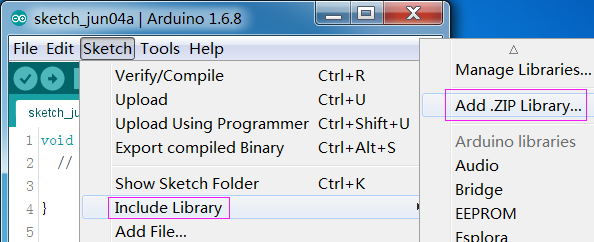
3) Find the file LiquidCrystal_I2C which you just download. Click it open and then you'll be prompted by "Library added to your libraries. Check 'Import libraries'”. You also can see the libraries just imported have appeared on the list by Sketch->Include Library->LiquidCrystal_I2C.
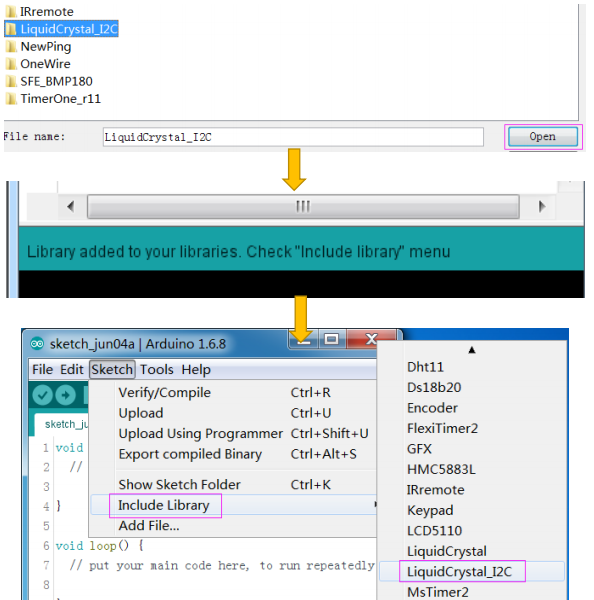
Copy the code
Copy the following code to the Arduino IDE
/*****************************************
* name: I2C LCD2004
* function: You should now see your I2C LCD2004 display "Hello,world!","IIC/I2C LCD2004"
* "20 cols, 4 rows","www.sunfounder.com"
********************************/
//Email:service@sunfounder.com
//Website:www.sunfounder.com
/********************************/
// Include necessary libraries
#include <Wire.h>
#include <LiquidCrystal_I2C.h>
// Initialize the LCD object, set the LCD I2C address to 0x27 for a 20x4 display
LiquidCrystal_I2C lcd(0x27, 20, 4);
/*********************************************************/
void setup()
{
lcd.init(); // Initialize the LCD
lcd.backlight(); // Turn on the backlight
// Set cursor to the top left corner and print the string on the first row
lcd.setCursor(0, 0);
lcd.print(" Hello, world! ");
// Move to the second row and print the string
lcd.setCursor(0, 1);
lcd.print(" IIC/I2C LCD2004 ");
// Move to the third row and print the string
lcd.setCursor(0, 2);
lcd.print(" 20 cols, 4 rows ");
// Move to the fourth row and print the string
lcd.setCursor(0, 3);
lcd.print(" www.sunfounder.com ");
}
/*********************************************************/
void loop()
{
// Empty loop
}
/************************************************************/
Upload the code
Before upload the code ,you need to select correct Board and Port,please follow the steps:
1) Click Tools ->Board and select Arduino/Genuino Uno.

2) Then select Tools ->Port.
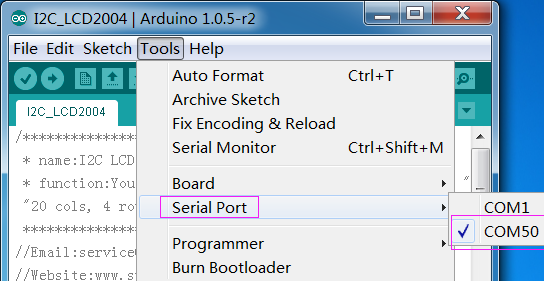
3) Click to the upload icon to upload the code to the control board
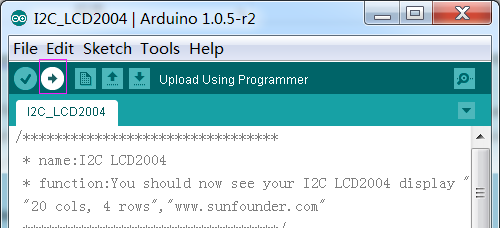
If "Done uploading" appears at the bottom of the window, it means the sketch has been successfully uploaded.
Read I2C Address
If everything is correct, but the display just shows 16 black rectangles on Line 1.it may be the address of i2c is not 0x27,therfore you need to run the following code to read the address,then modify the 0x27 to which you read.
LiquidCrystal_I2C lcd(0x27,16,2);
/*****************************************************
* Name: I2C_Address
* Function: Read the address of the I2C LCD1602
* Connection:
* I2C Arduino UNO
* GND GND
* VCC 5V
* SDA A4 (pin 20 in Mega2560)
* SCL A5 (pin 21 in Mega2560)
********************************************************/
#include <Wire.h> // Include Wire library for I2C communication
void setup() {
Wire.begin(); // Initialize I2C communication
Serial.begin(9600); // Start serial communication at 9600 baud rate
Serial.println("\nI2C Scanner"); // Print a message to the serial monitor
}
void loop() {
byte error, address; // Declare variables for storing error status and I2C address
int nDevices; // Variable to keep track of number of devices found
Serial.println("Scanning..."); // Print scanning message
nDevices = 0; // Initialize the device count to 0
// Loop through all possible I2C addresses (1 to 126)
for (address = 1; address < 127; address++) {
Wire.beginTransmission(address); // Start a transmission to the I2C address
error = Wire.endTransmission(); // End the transmission and get the status
// Check if device responded without error (acknowledged)
if (error == 0) {
Serial.print("I2C device found at address 0x"); // Notify device found
if (address < 16) Serial.print("0"); // Print leading zero for addresses less than 16
Serial.print(address, HEX); // Print the address in hexadecimal
Serial.println(" !");
nDevices++; // Increment the device count
} else if (error == 4) { // If there was an unknown error
Serial.print("Unknown error at address 0x"); // Notify about the error
if (address < 16) Serial.print("0"); // Print leading zero for addresses less than 16
Serial.println(address, HEX); // Print the address in hexadecimal
}
}
// After scanning, print the results
if (nDevices == 0)
Serial.println("No I2C devices found\n"); // No devices found
else
Serial.println("done\n"); // Scanning done
delay(5000); // Wait 5 seconds before the next scan
}
For Raspberry Pi User
Build the circuit
Setup I2C
Enable the I2C port of your Raspberry Pi (If you have
enabled it, skip this; if you do not know whether you have done that or
not, please continue).
Step 1: Run the following command.
sudo raspi-config
Step 2: 3 Interfacing options.
Step 3: P5 I2C.
Step 4: <Yes>, then <Ok> -> <Finish>.
Step 5: Check whether the i2c modules are loaded and active.
lsmod | grep i2c
Step 6: Then the following codes will appear (the number may be different).
i2c_dev 6276 0 i2c_bcm2708 4121 0
Step 7: Install i2c-tools.
sudo apt-get install i2c-tools
Step 8: Check the address of the I2C device.
i2cdetect -y 1 # For Raspberry Pi 2 and higher version
i2cdetect -y 0 # For Raspberry Pi 1
pi@raspberrypi ~ $ i2cdetect -y 1
0 1 2 3 4 5 6 7 8 9 a b c d e f
00: -- -- -- -- -- -- -- -- -- -- -- -- --
10: -- -- -- -- -- -- -- -- -- -- -- -- -- -- -- --
20: -- -- -- -- -- -- -- 27 -- -- -- -- -- -- -- --
30: -- -- -- -- -- -- -- -- -- -- -- -- -- -- -- --
40: -- -- -- -- -- -- -- -- -- -- -- -- -- -- -- --
50: -- -- -- -- -- -- -- -- -- -- -- -- -- -- -- --
60: -- -- -- -- -- -- -- -- -- -- -- -- -- -- -- --
70: -- -- -- -- -- -- -- --
If there is an I2C device connected, the address of the device will be displayed.
Step 9: Install libi2c-dev or smbus.
For C language users
sudo apt-get install libi2c-dev
For Python users
sudo pip3 install smbus2
Download and run the code
Step 1: Download the code package.
wget http://wiki.sunfounder.cc/images/3/36/I2c_lcd2004_for_raspberry_pi.zip
Step 2: Extract the package
unzip I2c_lcd2004_for_raspberry_pi.zip
(For C Language Users)
Step 3: If you have not installed wiringPi, then you will need to install it first.
sudo apt-get update git clone https://github.com/WiringPi/WiringPi cd WiringPi ./build
Step 4: You can test whether the wiringPi library is installed successfully or not by the following instruction.
gpio -v
Step 5: Get into the folder of code.
cd ~/I2c_lcd2004_for_raspberry_pi/c
Step 6: Compile.
gcc lcd2004.c -o lcd2004 -lwiringPiDev -lwiringPi
Step 7: Run.
sudo ./lcd2004
(For Python Users)
Step 3: Get into the folder of code.
cd ~/I2c_lcd2004_for_raspberry_pi/python
Step 4: Run.
sudo python lcd2004_show.py
Resources
Arduino I2C LCD2004 Code ![]()
LiquidCrystal_I2C library ![]()
Raspberry Pi I2C LCD2004 Code ![]()
PCF8574T_datasheet ![]()
